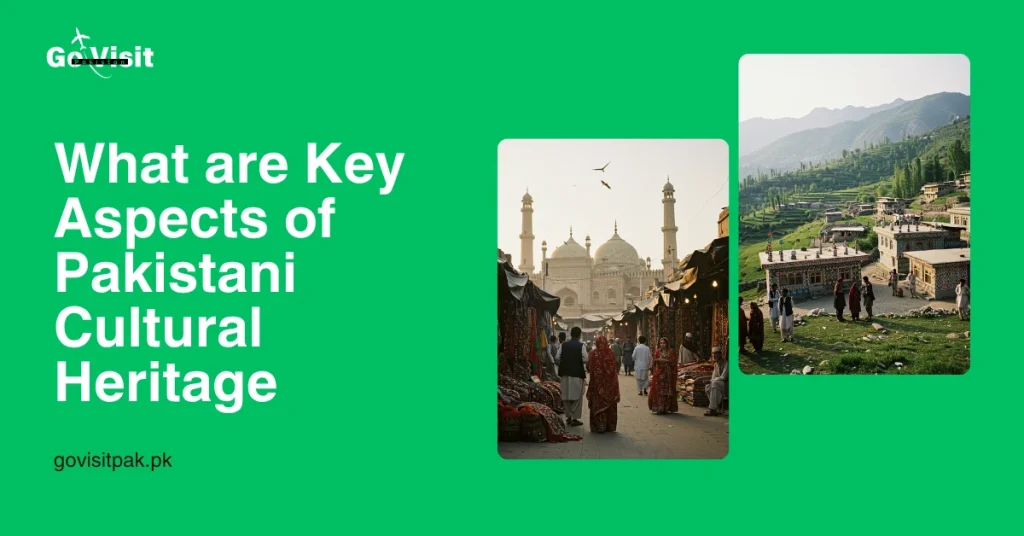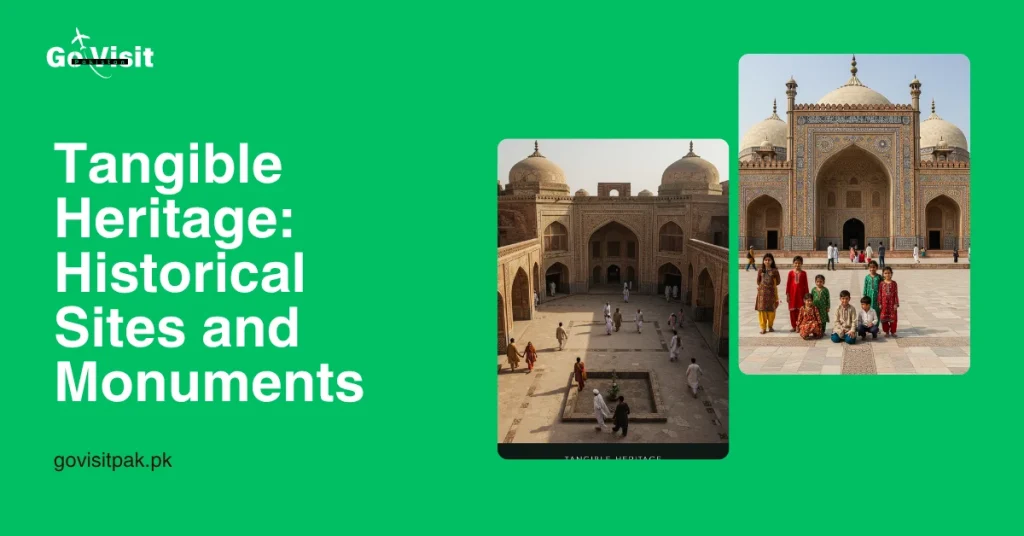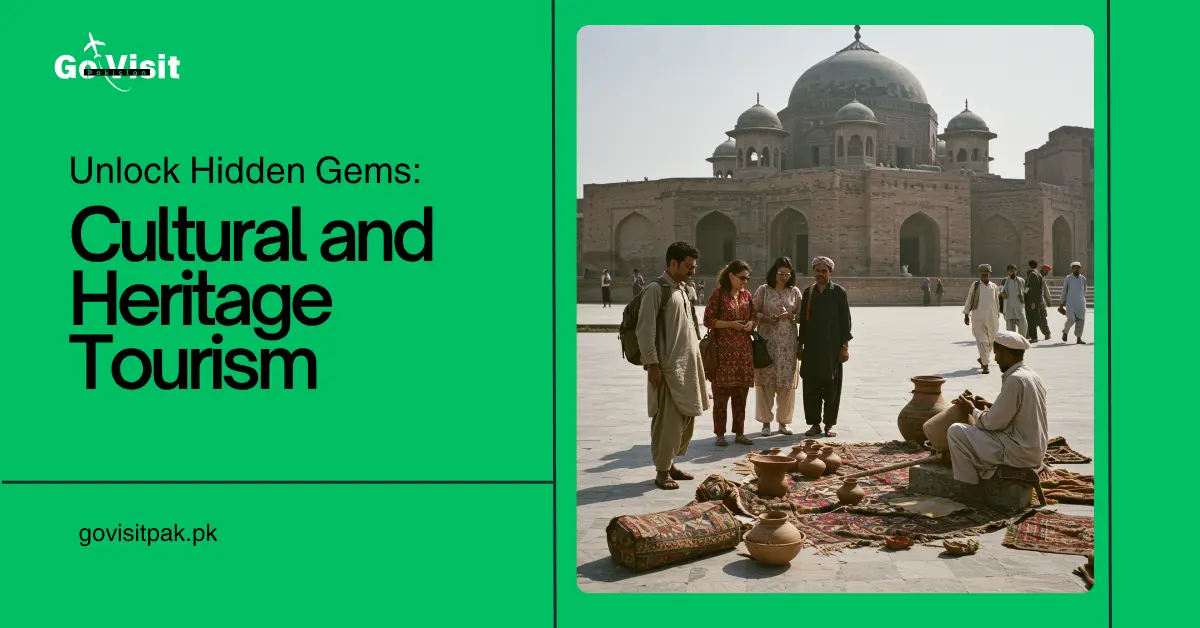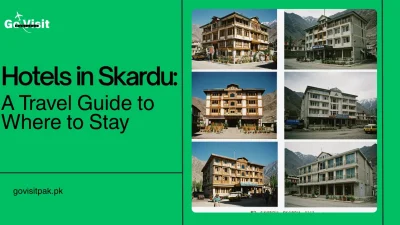This article will introduce you to Pakistan’s rich cultural heritage, including its ancient foundations, regional contrasts, tangible and intangible heritage, and UNESCO World Heritage Sites.
You will learn about historical sites, regional cultures, traditional arts, music, and festivals. Pakistani culture is a blend of history, creativity, and community, making it important to preserve it for future generations.
Pakistan possesses a rich and multicultural cultural heritage, including archaeological sites, historical monuments, and the vibrant traditions of its various regions.
Cultural and Heritage Tourism offers a deep dive into traditions, history, and authentic experiences. Discover your next unforgettable adventure.
The country’s culture has been influenced by prehistoric civilizations, including the Indus Valley Civilization, the Gandhara Civilization, and the Islamic periods. From the grand mosques of the Mughal era to traditional handicrafts, Pakistani culture is defined by a deep respect for history and tradition.
Cultural heritage is not something that exists merely in the past—it is living and existing as part of everyday life. Through music, art, celebration, and cooking, Pakistan’s culture brings people together and reinforces its national character. But even in an age of modernity, it would be wise to preserve these things for the coming times.
What are Key Aspects of Pakistani Cultural Heritage?

Pakistan’s cultural heritage is shaped by many historical and social forces.The country’s rich history includes ancient civilizations, Islamic heritage, regional diversity, and artistic expressions. The Indus Valley Civilization laid the foundation for urban life, trade, and crafts. Islam brought with it new traditions, architecture, and values afterwards.
Each province—Punjab, Sindh, Balochistan, and Khyber Pakhtunkhwa—is unique in terms of language, attire, song, and festivity, so the multicultural heritage of Pakistan becomes richer. The handicrafts, folk songs, poetry, and festivities also reflect the wealth of the country. They all form a solid tradition that ties people of Pakistan to their heritage and past.
Some of the key aspects include:
Ancient Roots
Pakistan’s cultural heritage is a highly advanced city civilization that thrived well over 5,000 years ago.
The cities of Mohenjo-Daro and Harappa were renowned for their well-designed roads, advanced drainage system, and excellent craftsmanship.
This civilization was the foundation of early trade, art, and technology and left us with vital archaeological sites that are still being researched even today.
Islamic Influence
Islam has significantly impacted Pakistani culture, with Islamic ideology, customs, and values playing a prominent role. The spread of Islam in the 8th century introduced Arabic, Persian, and Mughal elements into art, architecture, and literature.
Mosques, calligraphy, and Islamic poetry gained prominence as key elements of Pakistan’s cultural identity.
The Mughals constructed magnificent buildings, such as the Badshahi Mosque and Lahore Fort, which are still iconic symbols of Pakistan’s heritage.
Varied Regional Cultures
Every province of Pakistan has distinct cultural traditions, languages, and customs. Punjab boasts Bhangra dance and Sufi poetry, Sindh Ajrak and Sufi music, Balochistan folk storytelling and embroidery, and Khyber Pakhtunkhwa Pashto music and Attan dance.
Despite regional variation, these aspects of Pakistani culture bond the people together and provide a rich, common heritage.
Tangible Heritage: Historical Sites and Monuments

There are many historical sites in Pakistan that exhibit its rich, ancient heritage. These sites are a fundamental part of the nation’s identity and are preserved as national monuments. They tell about cultures, rulers, and civilizations of the past.
One remarkable example is the ancient city of Mohenjo-Daro, which belonged to the Indus Valley Civilization. The splendor of Mughal architecture is reflected in the Badshahi Mosque and Lahore Fort. The Buddhist influences are evident in the Taxila ruin.
These sites educate people about history and attract visitors worldwide. They will be preserved so that future generations can appreciate Pakistan’s diverse cultural heritage and connect with their roots. Some of the most notable ones are:
Archaeological Sites:
Numerous ancient archaeological sites that help us understand past civilizations can be found in Pakistan. These sites show how people built cities, developed cultures, and created better systems for living. Historians can learn a lot about ancient life, architecture, and technology from the ruins.
To keep their historical significance, many of these locations are protected. These places are visited by tourists and researchers to learn about the achievements of early societies.
For future generations to understand their heritage and appreciate history, it is important to preserve these sites. By protecting them, we ensure that the stories of the past continue to teach and inspire people worldwide.
- Mohenjo-Daro: An ancient city of the Indus Valley Civilization, with well-designed streets and drainage system.
- Takht-i-Bahi and Sahr-i-Bahlol: Ruins of an ancient Buddhist monastery, featuring Gandhara art.
- Taxila: A hub of Buddhist studies and a significant trade center in ancient times.
Forts and Architectural Wonders
Pakistan’s remarkable forts and architectural wonders show the country’s long and glorious history. Rulers built these structures to display their power, serve as military bases, and protect their lands.
The detailed designs and thick walls of many forts prove the craftsmanship of ancient builders. These historical sites share stories of past battles, royal life, and cultural influences. Today, tourists and historians who are curious about the country’s history visit these forts.
- Rohtas Fort: Constructed by Sher Shah Suri, this huge fort is an example of military architecture.
- Lahore Fort: A magnificent Mughal fort with lovely gardens and palaces.
Shrines and Tombs
Many old tombs and shrines show Pakistan’s wide-ranging cultural and historical heritage. Saints, rulers, and scholars who played important roles in history are buried in these holy places.
Detailed carvings, colorful tile work, and complex designs decorate many of these tombs, showing the architectural skill of earlier civilizations.
Visitors gather at these places to pay their respects, learn about history, and admire the craftsmanship.
- Makli Hill: One of the world’s largest necropolises with rich tombs of various time frames.
Intangible Heritage: Arts, Crafts, and Traditions

Pakistan’s cultural heritage is maintained in monuments, arts, music, literature, and festivals. These traditions have been carried forward by generations and remain strong today. Folk music, such as Qawwali and Sufi poetry, reflects deep spiritual and emotional expressions. Traditional crafts like pottery, embroidery, and truck art showcase the talent of artisans.
Communities come together to celebrate during festivals like Basant, Eid, and the Shandur Polo Festival. Oral traditions and storytelling transmit wisdom and history. These cultural elements build people’s pride and unity, preserving Pakistan’s identity and connecting people to their roots.
Traditional Arts and Crafts
Pakistan is renowned for its handicrafts, pottery, and embroidery. Some of the famous crafts are:
- Ajrak and Sindhi embroidery: Classic textile designs with strong cultural importance.
- Truck art: A special and vibrant style of painting found on trucks throughout Pakistan.
- Multani blue pottery: Nicely crafted ceramics that showcase Mughal designs.
Music and Dance
Pakistan’s music and dance traditions are rich and deeply linked to its regional identities. Some of the most popular ones are:
- Qawwali: Sufi devotional songs popularized by Nusrat Fateh Ali Khan.
- Bhangra and Jhoomar: Punjab folk dances performed on festival and wedding days.
- Pashto Attan: A dance danced in rhythm in Khyber Pakhtunkhwa.
Literature and Language
The literary past of Pakistan is abundant, as poets and authors have contributed in different languages. Some of the key contributors are as follows:
- Allama Iqbal: Pakistan’s national poet and famous for his motivational poetry.
- Shah Abdul Latif Bhittai: A Sindhi Sufi poet whose poetry is all about love and devotion.
- Bulleh Shah: A Punjabi Sufi poet known for his mystical and spiritual poems.
Festivals and Celebration
There are a number of festivals which are being observed in Pakistan in order to develop social harmony within society. Some of the most noted ones include:
- Eid-ul-Fitr and Eid-ul-Adha: Islamic celebrations accompanied by prayers, feasts, and charity.
- Basant: A festival of kite-flying which announces the arrival of spring in Punjab.
- Shandur Polo Festival: A rare game of polo played on the highest polo field in the world.
These cultural festivities are an important part of preserving Pakistan’s identity and heritage.
UNESCO World Heritage Sites of Pakistan
There are several places of historical value in Pakistan, which have been recognized by UNESCO as World Heritage Sites due to their historical and cultural significance. These include:
- Mohenjo-Daro: A highly well-preserved city of the Indus Valley Civilization.
- Takht-i-Bahi and Sahr-i-Bahlol: Remains of ancient Buddhist with Gandhara art.
- Rohtas Fort: 16th-century fortified military structure with imposing defense buildings.
- Lahore Fort and Shalamar Gardens: Exquisite examples of Mughal architecture and garden art.
- Taxila: Historic site with remains of Buddhist monasteries, stupas, and ancient universities.
- Makli Hill: Large necropolis with tombs of different ages.
These historic sites are representative of Pakistan’s history and ought to be preserved for the coming generations.
Conclusion
The cultural legacy of Pakistan is a jewel of history, convention, and traditions. Starting with the ancient Indus Valley Civilization, the culture of the nation is a convergence of centuries-old human work with the Mughal era onward.
Linguistics, music, dance, celebrations, and crafts continue to mold Pakistan’s national identity.
Pakistan’s cultural heritage is a beauty of history, traditions, and art forms. From the ancient Indus Valley Civilization to the Mughal period and beyond, the nation’s culture is an amalgamation of centuries of human endeavor.
Linguistics, music, dance, festivals, and handicrafts still shape Pakistan’s national identity. However, urbanization, climate change, and neglect present challenges to saving this heritage.
The government, educational institutions, and communities must act to protect and promote Pakistan’s rich culture. By valuing and celebrating our cultural heritage, we ensure that future generations can connect with their roots.
FAQs
Why is cultural heritage important for Pakistan?
Cultural heritage is Pakistan’s history, identity, and traditions. It preserves the nation’s legacy for future generations and boosts tourism.
What are some popular cultural festivals in Pakistan?
Popular festivals in Pakistan include Eid-ul-Fitr, Basant, the Shandur Polo Festival, Lok Mela, and the Sindh Festival. These festivals reflect the country’s rich traditions.
How can Pakistan conserve its cultural heritage?
Pakistan can keep its heritage intact by protecting historical monuments, patronizing local craftspeople, encouraging cultural education, and promoting traditional art forms.
What are some famous archaeological sites in Pakistan?
Pakistan is home to ancient sites such as Mohenjo-Daro, Harappa, Taxila, and Takht-i-Bahi, which showcase the country’s deep historical roots.
How has Islamic culture influenced Pakistan’s heritage?
Islamic culture has shaped Pakistan’s art, architecture, language, and traditions. The influence is evident in grand mosques, calligraphy, poetry, and religious customs.
What role do regional cultures play in Pakistan’s heritage?
Each region in Pakistan has unique traditions, languages, and crafts. Punjab, Sindh, Balochistan, and Khyber Pakhtunkhwa contribute to the country’s cultural richness.
Why are UNESCO World Heritage Sites in Pakistan important?
UNESCO World Heritage Sites, like Lahore Fort, Rohtas Fort, and Shalamar Gardens, hold global recognition for their historical and cultural significance. Their preservation is vital for future generations.
How does Pakistani music and dance reflect its culture?
Pakistani music and dance, such as Qawwali, Bhangra, Jhoomar, and Pashto Attan, highlight the country’s vibrant traditions and celebrate joy, spirituality, and communal harmony.





